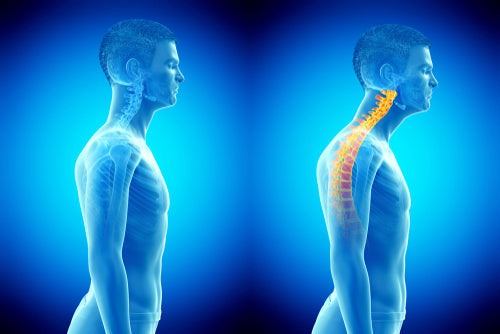Posture and Headaches: What is the Link?

If you have frequent headaches, a number of possible factors could be involved. But it is worth taking the time to check your posture. Poor posture is common, and may be a causal factor or a contributing one.
There are a number of different forms that bad waking posture can take, but the issue most frequently associated with head pain is what is referred to as "forward head posture."

Core Chiropractic states, “Tension and stress-related headaches are due to the weight of your head not being directly over your spine. When your head (which weighs about 10 lbs) is forward, every inch increases the pressure on your neck by an additional 10 lbs. Carrying that extra weight all day causes strain on the muscles and leads to headaches.”
Forward head posture tends to be exacerbated by frequent computer or smartphone use, and can also happen when you are reading a book.
WebMD explains, “A strong stance can help keep your muscles from tensing. When you stand, hold your shoulders back and your head level. Tighten your belly and buttocks. When you sit, make sure your thighs are parallel to the floor and your head and neck don’t slump forward.”
Your chin should be roughly level with the ground (or even slightly elevated, according to my chiropractor). You may want to reach back and feel the back of your neck with your hand to make sure that to whatever degree is possible, you are maintaining the curve in your neck.
It is worth noting that tension headaches are not the only ones associated with forward head posture. It may also be a factor in cervicogenic headaches.
This research explains, “Forward head posture is thought to increase stress on the upper cervical segments. Watson and Trott first noted that forward head posture was more common in CGH [cervicogenic headache] patients than other patients, which was also associated with weakness and decreased endurance of the deep neck flexors. More recently, however, Zito and colleagues found no significant differences in the prevalence of forward head posture in CGH or migraine patients compared to control subjects.”
For some people, pain that starts in the neck can also trigger migraines, so these too may be associated with bad posture.
As to the mixed results in association between CGH and forward head posture in the research above, it could be that it is a contributing or casual factor for some patients, but others may experience cervicogenic headaches even with ideal posture because of other structural issues.
One more thing to keep in mind is that it isn't just your daytime posture that can produce or worsen head pain, but also your posture as you sleep. Avoid sleeping on your stomach with your head twisted to the side. Lay on your back or your side. Side sleepers should try to maintain the straight alignment of their spines. Back sleepers should make sure they have adequate support to maintain the curve of the neck.
It can take time and effort to adjust your posture—it may feel unnatural at first, or even painful. If you think your spine is out of alignment, consider getting an adjustment by a chiropractor. Muscles that have shortened may also have a hard time lengthening again, especially if you have active trigger points. It is a process. But hopefully over time, you will see a reduction in head, neck and back pain with better posture.






